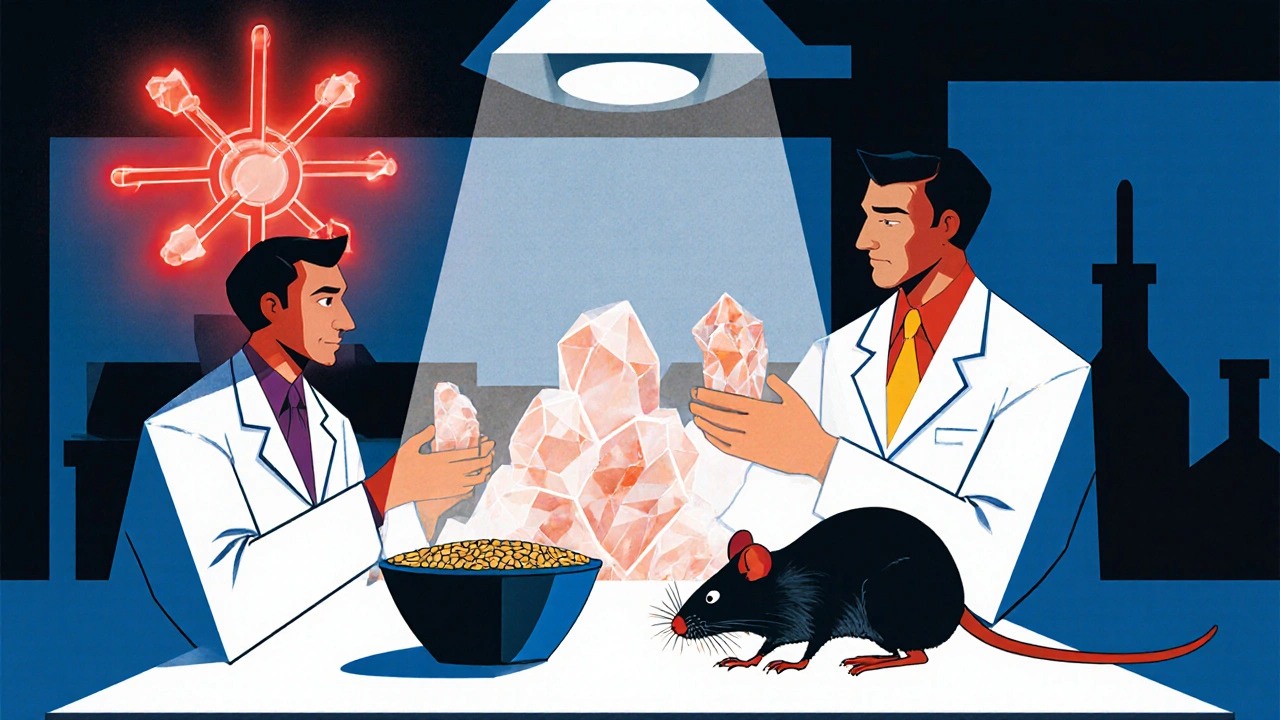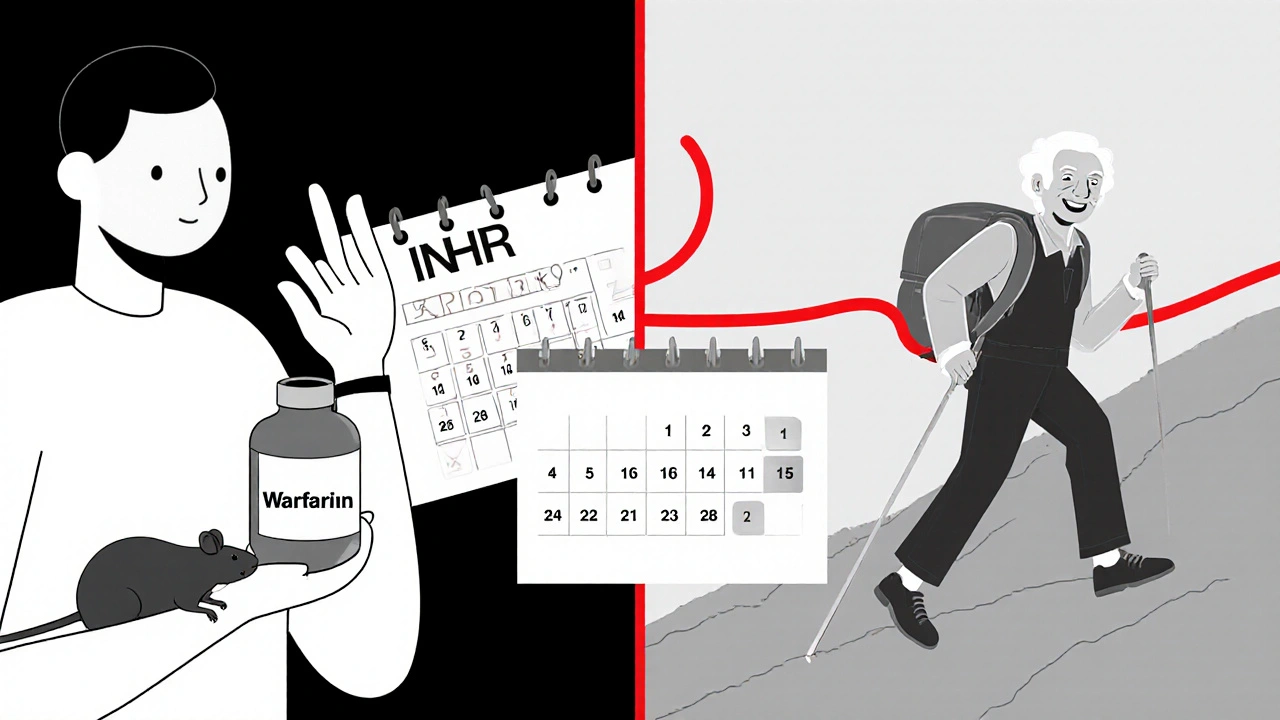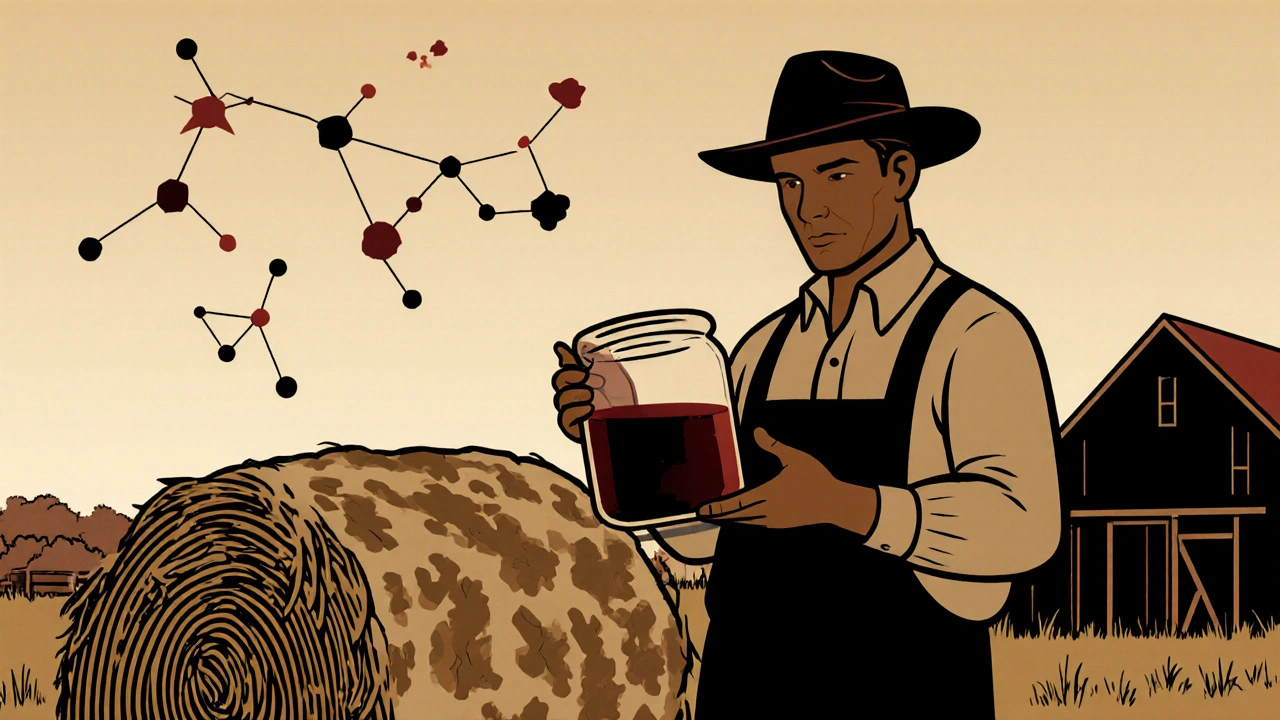Before it was used to save lives, warfarin was used to kill rats. In the 1920s, farmers in the northern United States and Canada noticed their cattle were bleeding to death after eating spoiled sweet clover hay. No one understood why-until a young dairy farmer named Frank Schofield started collecting blood samples and sending them to scientists at the University of Wisconsin. What they found was a strange, odorless substance in the moldy hay that turned healthy blood into a slow leak. That substance was dicoumarol, a natural anticoagulant. And it became the blueprint for one of the most widely prescribed drugs in modern medicine.
The Rat Poison That Changed Medicine
In 1941, chemist Karl Paul Link and his team at the University of Wisconsin isolated dicoumarol and figured out how to synthesize it. They wanted to create a better rodenticide-something stronger, longer-lasting, and cheaper. By 1948, they had developed warfarin, named after the Wisconsin Alumni Research Foundation. It worked brilliantly. Rats ate it, bled internally, and died quietly. By the early 1950s, warfarin was the go-to poison for pest control across North America.
Then came the twist.
In 1951, a U.S. Air Force pilot named James W. McCord tried to commit suicide by swallowing a large dose of warfarin. He didn’t die. Instead, he was rushed to the hospital, where doctors gave him vitamin K-the antidote-and he survived. That case caught the attention of Dr. Eugene P. Kennedy, a cardiologist who realized: if warfarin could stop blood from clotting in rats, maybe it could stop dangerous clots in humans.
By 1954, warfarin was approved for medical use in the U.S. The first patients? People with life-threatening blood clots-those who had suffered heart attacks, strokes, or deep vein thrombosis. It was the first oral anticoagulant that didn’t require daily injections. For the first time, people could take a pill at home to prevent deadly clots from forming.
How Warfarin Works
Warfarin doesn’t thin your blood. That’s a myth. It works by blocking vitamin K, which your liver needs to make clotting factors-proteins that help blood form clots when you’re injured. Without enough vitamin K, those proteins don’t get made. Your blood takes longer to clot. That’s helpful if you’re at risk for a clot forming inside a vein or artery. But it’s dangerous if you cut yourself or have a fall.
It’s a delicate balance. Too little warfarin, and you’re still at risk for stroke. Too much, and you could bleed internally without warning. That’s why people on warfarin need regular blood tests-called INR tests-to check how long it takes their blood to clot. The goal is usually an INR between 2 and 3. For some, like those with mechanical heart valves, it might be higher. For others, like those with atrial fibrillation, it might be lower.
There’s no one-size-fits-all dose. A 70-year-old woman with atrial fibrillation might need 3 mg a day. A 45-year-old man with a replaced heart valve might need 8 mg. It depends on weight, age, liver function, diet, and even what other drugs you’re taking. That’s why warfarin is one of the most carefully managed medications in the world.

Warfarin vs. Newer Blood Thinners
By the 2010s, a new generation of anticoagulants hit the market: dabigatran, rivaroxaban, apixaban, and edoxaban. These are often called NOACs-non-vitamin K oral anticoagulants. They don’t need regular blood tests. They have fewer food interactions. And for many people, they’re just as effective as warfarin.
But warfarin didn’t disappear. Why? Because it’s still the best option for some.
- If you have a mechanical heart valve, warfarin is still the gold standard. NOACs aren’t approved for this use.
- If you’re pregnant, warfarin is dangerous-but not for the reason you think. It can cross the placenta and cause birth defects. So doctors switch pregnant women to heparin injections. But after delivery, warfarin is often restarted because it’s safe while breastfeeding.
- If you’re on a tight budget, warfarin costs about $5 a month. Some NOACs cost over $400 a month without insurance.
- Warfarin has an antidote-vitamin K and a special protein called idarucizumab-that can reverse its effects in minutes if someone bleeds badly. Not all NOACs have this.
So while newer drugs are popular, warfarin remains a vital tool. It’s not outdated-it’s just different.

What You Need to Know If You’re Taking Warfarin
If you’re on warfarin, here’s what actually matters:
- Keep your vitamin K intake steady. Leafy greens like kale, spinach, and broccoli are full of vitamin K. You don’t have to avoid them-just eat about the same amount every week. A sudden big salad one day and none the next can throw your INR off.
- Avoid alcohol. Heavy drinking can increase your bleeding risk. Even moderate drinking can interfere with how your liver processes the drug.
- Tell every doctor you see. Even your dentist needs to know. Some antibiotics, antifungals, and painkillers can change how warfarin works. St. John’s wort, ginseng, and garlic supplements can too.
- Watch for signs of bleeding. Unusual bruising, pink or red urine, black stools, headaches with no cause, or vomiting blood? Call your doctor immediately.
- Don’t skip doses. If you miss one, take it as soon as you remember-but never double up. If you miss more than one, call your provider. Consistency is everything.
Many people on warfarin live full, active lives. They hike, travel, play with grandchildren, and go to work. But they do it with awareness. They track their diet. They know their INR numbers. They carry a medical alert card. That’s the secret: it’s not the drug that’s dangerous-it’s the lack of understanding.
Warfarin’s Legacy
Today, warfarin is prescribed to over 2 million people in the U.S. alone. In the UK, it’s still the most common anticoagulant. It’s been used for over 70 years. It’s been studied in more than 10,000 clinical trials. It’s saved countless lives-from the elderly with atrial fibrillation to young athletes who survived pulmonary embolisms.
It’s also one of the most misunderstood drugs. People hear “rat poison” and panic. But warfarin isn’t poison when used correctly. It’s a precision tool. Like a scalpel, it’s dangerous in the wrong hands-but life-saving in the right ones.
The same molecule that killed rats now helps people live longer. That’s not just science. It’s a story of accidental discovery, stubborn curiosity, and the quiet power of turning something deadly into something healing.
Is warfarin still used today?
Yes, warfarin is still widely used, especially for people with mechanical heart valves, those who can’t afford newer drugs, or those who need a drug with a known reversal agent. While newer anticoagulants are popular, warfarin remains a first-line option in many cases.
Why is warfarin called a rat poison?
Warfarin was originally developed in the 1940s as a rodenticide because it prevents blood from clotting, causing internal bleeding in rats. Its effectiveness against rodents led to its commercial use as a poison before its medical potential was discovered.
Can you eat leafy greens while taking warfarin?
Yes, but you must eat them consistently. Leafy greens are high in vitamin K, which warfarin works against. Sudden changes in your intake can affect your INR levels. The key is stability-not avoidance.
What are the side effects of warfarin?
The main risk is bleeding-bruising easily, nosebleeds, blood in urine or stool, or severe headaches. Other side effects include nausea, diarrhea, and skin rash. Most people tolerate it well when monitored properly.
How often do you need blood tests on warfarin?
When you first start, you might need tests every few days. Once your dose is stable, most people test every 4 to 6 weeks. Some use home INR monitors and test weekly or biweekly. Frequency depends on how steady your levels are.
Can warfarin cause liver damage?
Warfarin is metabolized by the liver, but it rarely causes liver damage. However, if you already have liver disease, your dose may need adjustment because your body processes it differently. Always tell your doctor about any liver conditions.
Is warfarin safe during pregnancy?
No. Warfarin can cross the placenta and cause birth defects, especially in the first trimester. Pregnant women on anticoagulants are switched to heparin injections. After delivery, warfarin is often restarted because it’s safe while breastfeeding.
What happens if you take too much warfarin?
Too much warfarin increases bleeding risk significantly. Symptoms include unexplained bruising, prolonged bleeding from cuts, blood in vomit or stool, or severe headaches. If you suspect an overdose, seek emergency care. Vitamin K or a blood product can reverse its effects quickly.
